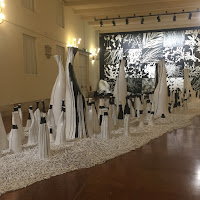Jheronimus Bosch: Venice Paintings Restored

Small exhibition at the Accademia in Venice looking at their Heronimus Bosch pictures and marking the six hundredth anniversary of his death. The exhibition looked in detail at recent conservation work on the pictures funded by the Bosch Research and Conservation Project explaining the cleaning process and looking at new things that had been found in the pictures. The odd thing though was that only one of the pictures was there. The others were on loan to the big show in Madrid. They had been replaced by very good quality reproductions of them. The real pictures will be returned before this show ends so it might be worth waiting to go. The painting which was there was a strange triptych of three hermit saints. Each saint was surrounded by images of their visions, an absolute gift to Bosch! Another showed the crucifixion of St Liberta, a female saint who sprouted a beard to put off an unwanted suitor. Closes 7 February 2017


























